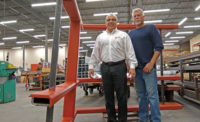During an interview in his office in the New York Life Insurance building in midtown Manhattan, Tom Scarangello can’t stop talking. He’s not even speaking about Thornton Tomasetti (TT), the international structural engineering consultant of which he’s CEO, although the discussion very much relates to it.
When he was chairman of the New York Building Congress from 2014 to 2016, Scarangello put together a committee on innovation, which eventually became that trade group’s Council on Innovation & Best Practices. He recalls that after traveling around the country and the world observing construction sector activity, he’d come back to New York City “frustrated by the lack of innovation and best practices here.” Laments Scarangello: “Construction is dead last among all industries for innovation, even though innovation is all around us, it’s just not widely distributed.”
Scarangello, still a co-chair of the council, enthuses about the Building Congress’ planned online portal, in which tristate companies can share ideas they’ve seen working elsewhere and things they’re creating that are in early stages. Then he’s asked if his passion and idea for the council could be traced to TT’s own innovations. The CEO gives a slight smile.
It’s clear from conversations with him and other company executives, clients and even a subcontractor that now is its co-developer of a new damping technology—as well as from reading past annual reports—that this is TT’s jam. The company is so dedicated to developing new tools and processes for the construction industry that it has developed a robust internal R&D unit and a spinoff company that brings AEC-focused technology to market—courting attention from venture capitalists, private equity and other investors and creating new revenue streams while spurring innovation.
That focus on moneymaking and growth also comes with a sense of industry altruism. The firm hosts many “hackathons,” at which technology developers from varying industries get together to create a usable app in just about a day, as well as symposiums that include other AEC companies. The Thornton Tomasetti Foundation continues to fund education and socially minded construction projects—more than $950,000 worth since 2008.
TT’s successful integration of multiple missions generated its selection as ENR New York’s Design Firm of the Year for 2018. The firm ranks No. 15 on this year’s Top Design Firms list, reporting regional design revenue of $90.77 million. Worldwide, TT had design revenue totaling $265 million. The firm also placed among the top 10 on many of the regional survey’s sector rankings: holding the No. 2 slot in both structural engineering and exterior facade design; No. 4 in regional green design, commercial and religious/cultural markets; and No. 5 in government/public service.
Innovation Payoff
Research and development was a top priority even before Thornton Tomasetti gained its current name. Co-founders Charles H. Thornton and Richard Tomasetti had both worked for its predecessor firm, Lev Zetlin & Associates, since the 1960s. Zetlin sold his firm in 1970 to Gable Industries because it promised to fund R&D. The two engineers bought it seven years later.
Aine Brazil, who stepped down as TT vice chairman at the end of 2017 and remains a board member, had been an engineer for just five years and newly arrived in the Big Apple during a recession in 1982. “No one was hiring,” she recalls in a phone conversation, “except for Lev Zetlin.” From her early days there, the firm proved its penchant for finding innovative ways to build structures. Brazil remembers that she and Scarangello both worked on “talls”—defined then as buildings of at least 30 stories—and that the firm was keen to optimize the use of lateral systems for such structures. Through the 1990s, she says, “we were just going gangbusters, getting things done” on numerous projects for a growing stable of clients.
Then the Sept. 11 terrorist attacks happened—generating a slowdown in New York City construction and a lull in work for TT employees. But that was a silver lining, Brazil says. “Post-9/11 was a slow period, but we didn’t waste it.… 3D modeling was just getting started. So we took the opportunity” to teach it to staff during the downtime. She says, understatedly: “We got slightly ahead of the curve with Tekla (structural design) modeling.”
But embracing new technology was not automatic in the industry, nor among all TT employees. Rob Otani, the firm’s newly appointed chief technology officer, says: “Most engineers do not want to do something different. ‘My work is good, why change?’”
In the end, however, customers drive innovation at TT and elsewhere in the industry. “I’ve found clients are more open to new ideas,” Brazil says. “If it can save them time or save them money, they’re definitely interested.”
Pushing the Envelope
That seems to be the case with real estate developer Hines, whose relationship as a TT client began in 1994, when the companies worked on the former Swiss Bank Corp. building in Manhattan. They would also partner on other New York City financial sector structures to come, for clients such as Morgan Stanley and the Royal Bank of Scotland.
Tommy Craig, a senior managing director in Hines’ New York office, hired TT in 2001 for a two-building complex in Jersey City, N.J., for which he was principal. “There were tremendous windloads on that building,” he says. The firm confronted the challenge, providing structural engineering services.
At the One Vanderbilt office tower now under construction near Grand Central Station, Craig says TT “in some way resolved all the forces in the building.” The firm’s construction engineering team used Tekla modeling to create shop drawings from building information modeling via TT’s proprietary software Konstru—which Otani calls “the Google Translate of BIM”—to interpret the BIM model as a Tekla model. The Hines executive sums up TT simply: “They’ve become absolutely fanatical about design innovation.”
That fanaticism was bolstered when TT acquired engineering and applied science firm Weidlinger Associates in 2016. “They had tremendous depth of innovation,” Brazil says. “That extra impetus helped us get over the big hump” in terms of TT introducing more new tech to the industry.
TT now owns various life sciences intellectual property (IP), including a heart stent on which the firm later modeled a submarine. “A heart is a pressure vessel with fluid running through it, and a submarine is a pressure vessel with fluid running through it,” Scarangello explains, adding that the stent’s design can also be applied to construction design.
Nabbing Weidlinger IP furthered Thornton Tomasetti’s drive to innovate. In 2016, executives of both companies launched the privately held company TTWiiN. The company, whose unusually spelled acronym incorporates both firms’ names and the word “incubator,” develops and commercializes new technologies. Its flagship product is Konstru, a 3D collaboration platform that lets users share data from different design and analysis packages, which was used for One Vanderbilt.
Otani oversees TT’s in-house R&D divisions, CORE studio and Core lab. The studio quickly creates computational tools for use within TT while the lab develops new methods, products or capabilities through projects proposed and led by company staff members. Otani says there are about 12 current R&D projects with three to four members on each team. Ideas are incubated internally and chosen for further funding and development by “a broader swathe of the office,” he says.
The CTO says apps being developed are intended for automation, interoperability, structures, artificial intelligence and data visualization. Lack of expertise in the latter “is a weakness in our industry,” he says. TT made its Design Explorer, a data visualization application, available as open source technology. Otani says a software firm built a proprietary product that was based on Design Explorer. “In a way, it was a nice thing because it told us we were onto something,” he says.
Otani, who was on the team that designed the Tata Innovation Center for the new Cornell University campus on Roosevelt Island in Manhattan, has an engineer’s enthusiasm for minutiae and a C-suite executive’s savvy to proffer those details to a potential client not familiar with innovative tools and services TT can offer. He gushes about 3D printing everything from houses to bandshells to an artistic exhibit that includes steel framework and living plants.
The innovation push commands a lot of resources in terms of time, money and personnel. But Otani says that successful products can offer a 5-to-1 return on investment.
Staffers who were the brains behind them can become equity holders and receive bonuses, an approach that allows younger employees and future prospects to “make a contribution,” as Brazil puts it, to the industry and become more connected to the firm.
R&D can also foster new relationships with old allies. Engineer RWDI, which specializes in wind engineering and environmental assessment, is often a TT subcontractor. In the past year, they’ve worked on several major projects in New York City, Chicago, Bangkok and other global locations. The two became partners in 2017 on Hummingbird Kinetics, a tuned liquid damper that adapts NASA technology to minimize wind-induced sway in bridges and buildings. TT is “very keen to progress innovation in design,” says Mike Soligo, RWDI president and CEO. Hummingbird, a TTWiiN product, is starting implementation.
With fingers in so many pies, it’s hard to predict what’s next for TT. “Process innovation, where money can be saved and time can be saved, is maybe where we might make a contribution to the future,” Brazil surmises.
In May, the firm announced it had acquired England-based MFD, a security consulting firm with 26 staff members and $6 million in fiscal 2017 revenue. The merger will help TT boost security offerings—to protect against vehicle attacks and bombings as well as provide technology for thumbprint readers and retinal scans—in Europe and worldwide.
In 2009, the firm polled its employees, who now number more than 1,200 globally, about where they thought the company should be in 20 years. Scarangello says the answer he got back was “to be a global driver of change and innovation in our industry.”











Post a comment to this article
Report Abusive Comment